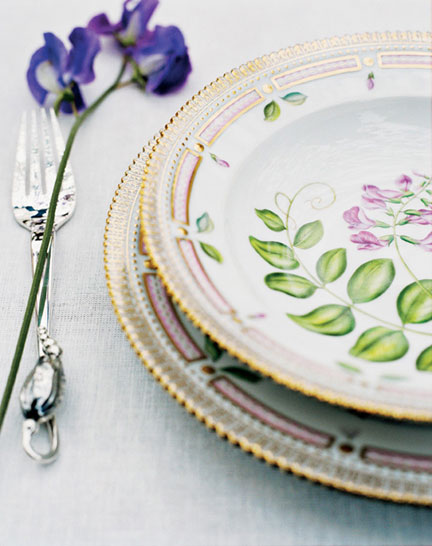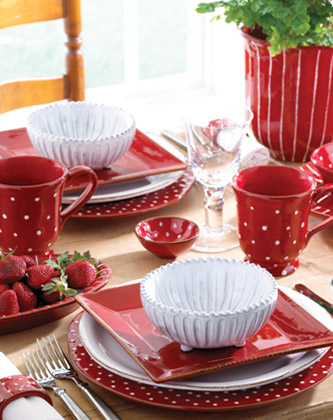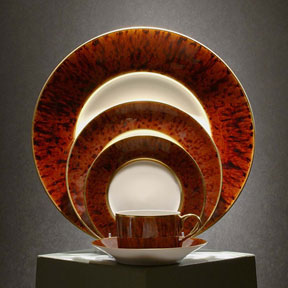Save to...
Guide to Choosing Dinnerware
Selecting a dinnerware collection is an exciting task! With a myriad of options to choose, we at Gracious Style are here to help narrow your search, and find the style that is perfect for you. Whether you are looking for formal china, or fun, everyday essentials, we break down the basics and answer any questions that may arise.
Understanding Dinnerware Materials
What are the different types of materials used to make dinnerware?
Luxury dinnerware is usually made of either porcelain or bone china. Casual dinnerware is made from earthenware or stoneware because these are usually more durable, easier to care for, and lower in price.
– Porcelain: The key ingredient, kaolin, is what makes porcelain so extraordinary. Fired at a the highest temperatures, porcelain combines a stark white appearance with incredible durability to make timeless pieces that will last in beauty and reliability for years to come. Well-known names to consider include Raynaud, Haviland, and Philippe Deshoulieres. And if you appreciate hand-painted porcelain, Herend and Anna Weatherley make beautiful pieces.
Care: Most porcelain items are dishwasher and microwave safe. We recommend hand washing for larger pieces, handpainted collections, or items with gold or platinum decoration. Items with metallic decoration should not be microwaved.
– Bone China: This is a very fine, soft-paste clay that is made from several key ingredients, including bone ash. The result is a beautiful, high translucency white with warm, ivory tones. Considered by many to be the finest quality of china, it has great strength and very high chip-resistance. Brands we suggest: Pickard, Royal Crown Derby.
Care: Most bone china items are dishwasher and microwave safe. We recommend hand washing for larger pieces or items with gold or platinum decoration. Items with metallic decoration should not be microwaved.
– Stoneware: Ideal for casual dining, stoneware is fired at very high temperatures to produce pieces which are durable and quite chip-resistant. Available in a numerous range of colors, some pieces also have beautiful crackled surfaces. Brands we suggest: Gien, Jars, Juliska, Vietri.
Care: Dishwasher, microwave, oven, and freezer safe.
– Earthenware: as it is fired at relatively low temperatures, this type of pottery is more porous and less translucent than either porcelain or bone china. These pieces are relatively thick and heavy, and their natural colors range from from buff to red, depending on the clay used. A much-beloved characteristic of earthenware is that it is likely to crackle as the clay expands and contracts, but this does not affect the use of the piece. Brands we suggest: Vietri.
Care: Dishwasher safe; most are microwave safe on low to medium settings. We recommend avoiding sudden temperature changes.
What is Limoges porcelain?
Limoges refers to a region in France where some of the earliest porcelain pieces were produced as far back as 1765. For centuries, the name Limoges has represented the finest quality and craftsmanship in porcelain throughout the world. Limoges porcelain is very white; most of the best-known producers of French porcelain are based in Limoges.
What are some simple ways to determine quality in dinnerware?
You can determine the quality of porcelain and fine china with a few simple tests:
– Hold the piece up to the light and you should be able to see the shadow of your hand behind the porcelain.
– Flick the plate with your fingers and listen for a resonant ring.
– Examine the color and make sure the glaze is even; the finish should be smooth and lustrous.
Dinnerware Styles
What dinnerware styles are available?
Generally, dinnerware is broken down into casual and formal collections. From there, you can choose between four major styles: solid (meaning one color throughout, with no pattern), banded, patterned, and handpainted.
If you’re looking for something with a monogram or in a specific color, take a look at our custom dinnerware collections.
And for outdoor entertaining, there are also outdoor dinnerware collections available.

Suggested Quantities
How many dinnerware collections do I need?
In making this decision, we suggest considering the size of your family, the type of entertaining you are most likely to do (formal seated dinners or buffet brunches), and the complexity of your menus. Many people choose to have at least one casual collection for everyday use and one formal collection for selected occasions (usually porcelain).
How many settings do I need?
We recommend registering for twelve five-piece place settings, as these will see you through most dinner parties. These five-piece settings typically include a dinner plate, salad or dessert plate, bread and butter plate, tea cup, and tea saucer. On more casual collections, you will sometimes see four-piece settings available. These normally include a dinner plate, salad plate, bowl, and mug. While you may not always be entertaining for twelve, having additional pieces will guarantee that you have spares when items break or unexpected guests show up. From time to time, collections or specific pieces do get discontinued, so if you love a piece, buy it while you can.

What is included in a five-piece place setting?
A five-piece formal setting consists of a dinner plate, salad plate, bread/butter plate, teacup, and saucer.
What is included in a four-piece place setting?
On more casual collections, you will sometimes see four-piece settings available. These normally include a dinner plate, salad plate, bowl, and mug.
What are standard dinnerware sizes?
Sizes sometimes vary slightly among different collections, but they are generally as follows:
| Presentation Plate | 12″ diameter |
| Dinner Plate | 10.5″ diameter |
| Dessert Plate | 8.5″ diameter |
| Salad Plate | 7.5″ diameter |
| Bread/Butter Plate | 6.75″ diameter |
What is a presentation plate?
Also known as chargers or buffet plates, presentation plates are oversized plates (12″ diameter) designed to add color and style to your table setting. These are usually removed before the main course is served, although they are also frequently used as buffet dinner plates since they can hold larger quantities of food.
What kinds of serving pieces do I need?
When registering for dinnerware, it is easy to overlook serving pieces. However, these items are not only great for unifying your collection, they are necessities that will be essential for cooking, entertaining, and everyday dining. We recommend the following as a starting point:
– Two to three serving dishes
– Two serving bowls or salad bowls
– One covered casserole dish
– One cake platter (or better yet, a cake stand for a better presentation)
– One tea and/or coffee service (this should include the teapot or coffee pot, creamer, and sugar bowl)
Caring for Dinnerware
How do I care for my dinnerware?
Most dinnerware items are microwave and dishwasher safe, unless they are decorated with gold or silver. We recommend hand washing for larger pieces, handpainted collections, or items with gold or platinum decoration. Items with metallic decoration should not be microwaved.
Monogramming
How should I monogram my dinnerware?
If you choose to have your dinnerware monogrammed, consider several different options. Single-letter monograms usually feature the first initial of the last name. On three-letter monograms, most individuals choose to have their first, middle, and last or first, last, and middle initials embroidered. For married couples, a popular choice is the initials of the couple’s first names on either side of their married last name.
Would you like to see more styles? Click here to view all our dinnerware collections.



















